eleusis-borodin
Harmless

Posts: 10
Registered: 20-2-2015
Member Is Offline
Mood: No Mood
|
|
Two depictions of the same molecule.
This is a special case, and since I am asking about compounds as they are depicted in the published version of PIHKAL VS how they are depicted
elsewhere, I had to use these specific compounds.
The 2,5-dimethoxy-4-x-phenethylamines/amphetamines can be depicted in two orientations. This is because the molecule is not planar and can be rotated
on its axis, when this occurs the methoxy groupings appear to rotate from positions 2 and 5 to positions 3 and 6.
Picture attached.
In PIHKAL the molecules are depicted in one orientation, while in the research papers of David E. Nichols for example, they are depicted in another.
As I said, both depictions are correct, as the molecule is not planar, and can be rotated on its axis.
... but how would you know if they were trying to represent the methoxy groupings on atoms 2 and 5 or 3 and 6, when each position can represent the
other depending on the molecules orientation in space?
I noticed in PIHKAL (the published version, not the online erowid version) that Alexander shulgin depicts his 2,5-dimethoxy-4-x-phenethylamines with
the double bonds of the benzene ring oriented to reflect that the molecule had been rotated.
Again, The molecule is not planar, and can be rotated on axis, making carbon atoms 2 and 5 appear to change to positions 3 and 6. If you move this
molecule on its axis in a 3D model, you can watch this occur, also while watching this in the 3D model, I noticed that the doubles bonds in the
benzene ring switch position as well.
In another thread I speculated on this, and really wanted to understand it, but must have said or done something incorrect as the response was quite
negative, and while I'm not certain why, this question has been driving me crazy.
It has to be the double bonds right?
Notice the orientation of the double bonds in my hand drawing.
Can someone please explain this to me? I have been trying to understand this issue for sometime, and in every situation nobody has been able to
explain it to me in a way that I could understand, I know that in benzene each single bond is a sigma bond and that each double bond is actually a One
sigma and one pi bond and so on, this is not what I am asking about, I understand the properties of benzene and so fourth.
In the pictures below first we see 2,5-dimethoxy-4-bromo-amphetamine depicted as it appears in the published version PIHKAL, then next to it there is
a 2,5-dimethoxy-4-x-amphetamine in the orientation as it appears in research papers and in other places.
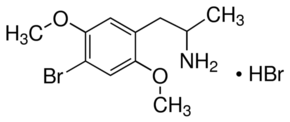 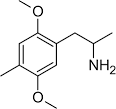
When the molecule rotates on its axis, not only do the methoxy groupings at 2 and 5 switch orientation to appear to be at 3 and 6, but the doubles
bond appear to switch orientation as well.
Is this correct? Is there something here that I am still not understanding?
[file]58929[/file] [file]58930[/file] 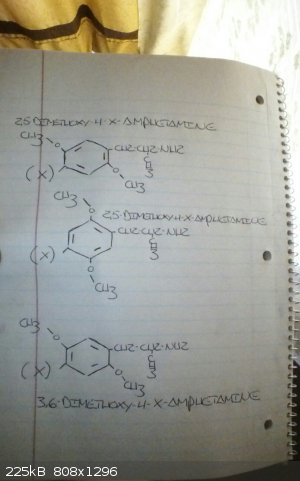
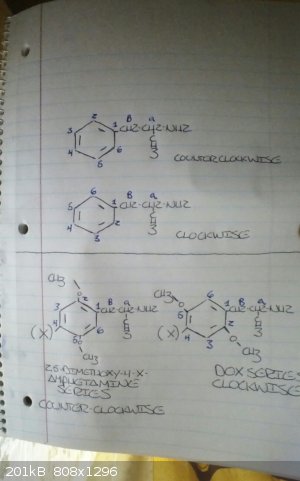
[Edited on 6-5-2017 by eleusis-borodin]
[Edited on 6-5-2017 by eleusis-borodin]
|
|
|
Praxichys
International Hazard
    
Posts: 1063
Registered: 31-7-2013
Location: Detroit, Michigan, USA
Member Is Offline
Mood: Coprecipitated
|
|
Your understanding of benzene is incorrect. The benzene system is aromatic, which is to say that although the summation of the bonds involved function like three single and three double bonds, the system
is actually a delocalized array of pi-bonds due to structural resonance. The differences you see in the pictures in PHIKAL are simply coincidental to the way the benzene ring was
drawn. Many textbooks eliminate confusion by depicting benzene as a hexagonal circle of carbons with a circle inside to represent the resonance, but
many others simply choose to draw three alternating double bonds in an arbitrary orientation, as in PHIKAL. Both are correct.
|
|
|
Alice
Hazard to Others
  
Posts: 111
Registered: 11-5-2015
Member Is Offline
Mood: No Mood
|
|
Not sure what your problem is. For freely rotable bonds it doesn't matter how it's drawn. Benzene doesn't have double bonds but a 6pi electron system,
therefor drawing three bonds is just a representation suitable for visualizing mechanisms. For the nomenclature there are IUPAC rules and the name of
a molecule doesn't depend on how it's drawn. Hope this helps.
|
|
|
eleusis-borodin
Harmless

Posts: 10
Registered: 20-2-2015
Member Is Offline
Mood: No Mood
|
|
Please do not become frustrated, I know that I can be a very difficult learner, please try to bear with me here:
while what you explained about benzene is correct, and the response is appreciated, it's not the issue here, I know I do not do a very good job of
articulating these concepts, and for that I apologize...I will try to be a clear as possible.
( though I want to explain the bonds in benzene real quick, pay no mind to it as it is not related, though I felt I should explain:
So for benzene, there are 9 single sigma bonds and three double bonds using pi bonds I know that every carbon to hydrogen bond is a single covalent
bond, which makes 6 sigma bonds, as for the carbon to carbon bonds each single bond is a sigma bond, and each double bond is one sigma and one
pi...and so on, I'm fairly sure my understanding of benzene is ok. )
This is only an issue if you are working with both 2 and 5 substituted and 3 and 6 substituted (alpha-methyl)-phenethylamines on paper an have
difficulty distinguishing which was meant to be represented...you can not have two numbers for the same carbon atom, and that's exactly how things
appear as a result of rotating the non-planar molecule on its axis.
My issue is how would I know that the methoxy substitutions were intended to be represented at carbon 2 and 5 and not carbon atoms 3 and 6?
Like I said, both depictions are correct, the molecule is not planar, and can be rotated on its axis, if you take a 2,5-dimethoxy-4-x-phenethylamine
molecule in a 3-D model and rotate it on its axis, the carbon atoms at 2 and 5 will appear to move to positions 3 and 6, both depictions are correct,
but since you can not have two numbers for the same carbon atom you would need a method of being able to identify the orientation in space of the
molecule so you would know that the substitutions were intended to be at 2 and 5 and not 3 and 6.
When the molecule is rotated on its axis in a 3-D model, you will notice that as the methoxy substitutions appear to move to positions 3 and 6, the
orientation of the double bonds also seem to be in opposite orientation.
So in this image: 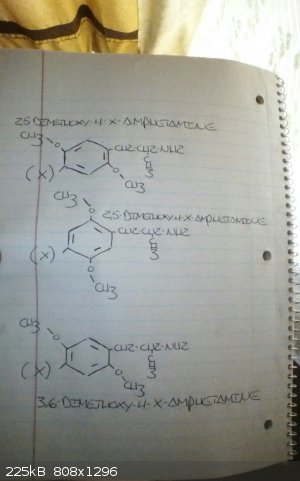 you will notice that you can distinguish the two correct orientations of 2,5-dimethoxy-4-x-amphetamine from the representation of a molecule where
the methoxy groupings are intended to be at 3 and 6 by the orientation of the double bonds in the benzene ring. you will notice that you can distinguish the two correct orientations of 2,5-dimethoxy-4-x-amphetamine from the representation of a molecule where
the methoxy groupings are intended to be at 3 and 6 by the orientation of the double bonds in the benzene ring.
|
|
|
Alice
Hazard to Others
  
Posts: 111
Registered: 11-5-2015
Member Is Offline
Mood: No Mood
|
|
| Quote: | | So for benzene, there are 9 single sigma bonds and three double bonds using pi bonds I know that every carbon to hydrogen bond is a single covalent
bond, which makes 6 sigma bonds, as for the carbon to carbon bonds each single bond is a sigma bond, and each double bond is one sigma and one
pi...and so on, I'm fairly sure my understanding of benzene is ok. ) |
I count 12 sigma bonds, 6 C-C, and 6 C-H. For the aromatic system there are 3 pi bonds delocalized between the 6 carbon atoms.
| Quote: | | My issue is how would I know that the methoxy substitutions were intended to be represented at carbon 2 and 5 and not carbon atoms 3 and 6?
|
According to the IUPAC nomenclature, the substituent with the highest priority* gets the number 1. For more substituents the numbers start as low as
possible.
Example:
It's 3-bromobenzoic acid and not 5-bromobenzoic acid.
With the second substituent being not para the direction of counting is determined!
For 2,5-dimethoxybenzoic acid, the substituent with the lowest distance from the acid moiety is 2, therefor the direction of counting is determined.
*See http://www.masterorganicchemistry.com/2011/02/14/table-of-fu... for a list of priorities of different functional groups or just look up the IUPAC
nomenclature.
[Edited on 6-5-2017 by Alice]
|
|
|
PirateDocBrown
National Hazard
   
Posts: 570
Registered: 27-11-2016
Location: Minnesota
Member Is Offline
Mood: No Mood
|
|
Far more important than the resonance of the ring is the chirality of the carbon vicinal to the amino group, which is not depicted. Since you are
inquiring about a potentially psychoactive substance, this distinction can be crucial.
I suggest your study of the basics of organic chemistry start with compounds that are not tarred with the stigma of illegality, and only once you have
mastered the science you should move on to those compounds that most interest you.
You would gain much more respect here on this board, as you would no longer appear to be a cook in training.
|
|
|
PirateDocBrown
National Hazard
   
Posts: 570
Registered: 27-11-2016
Location: Minnesota
Member Is Offline
Mood: No Mood
|
|
But to help you in your quest for understanding, there are no double bonds in benzene. The pi system is a unified bond, containing not 2, but 6
electrons, contained in clouds in circular configurations above and below the plane of the ring. These clouds of electron density can shift, depending
on the substituents on the ring, thus altering the ring's further reactivity.
That's the basics of benzene as best as I can explain. Hope it helps.
|
|
|
Nicodem
|
Thread Moved
6-5-2017 at 12:14 |
|